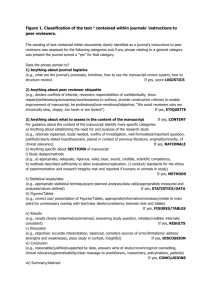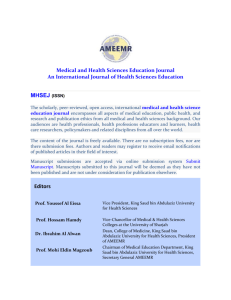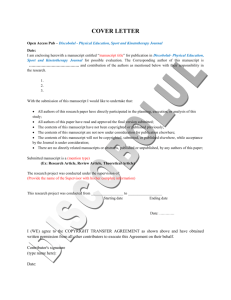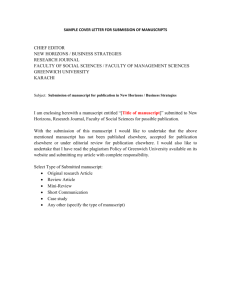Editorial Considerations for Manuscript Submissions
advertisement
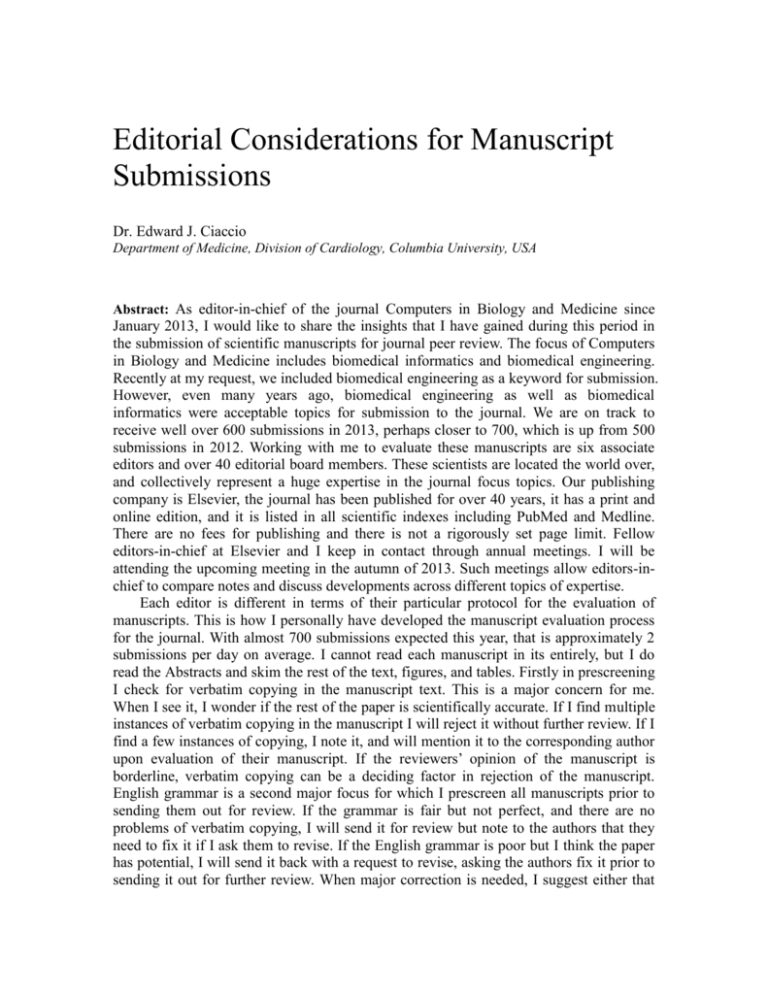
Editorial Considerations for Manuscript Submissions Dr. Edward J. Ciaccio Department of Medicine, Division of Cardiology, Columbia University, USA Abstract: As editor-in-chief of the journal Computers in Biology and Medicine since January 2013, I would like to share the insights that I have gained during this period in the submission of scientific manuscripts for journal peer review. The focus of Computers in Biology and Medicine includes biomedical informatics and biomedical engineering. Recently at my request, we included biomedical engineering as a keyword for submission. However, even many years ago, biomedical engineering as well as biomedical informatics were acceptable topics for submission to the journal. We are on track to receive well over 600 submissions in 2013, perhaps closer to 700, which is up from 500 submissions in 2012. Working with me to evaluate these manuscripts are six associate editors and over 40 editorial board members. These scientists are located the world over, and collectively represent a huge expertise in the journal focus topics. Our publishing company is Elsevier, the journal has been published for over 40 years, it has a print and online edition, and it is listed in all scientific indexes including PubMed and Medline. There are no fees for publishing and there is not a rigorously set page limit. Fellow editors-in-chief at Elsevier and I keep in contact through annual meetings. I will be attending the upcoming meeting in the autumn of 2013. Such meetings allow editors-inchief to compare notes and discuss developments across different topics of expertise. Each editor is different in terms of their particular protocol for the evaluation of manuscripts. This is how I personally have developed the manuscript evaluation process for the journal. With almost 700 submissions expected this year, that is approximately 2 submissions per day on average. I cannot read each manuscript in its entirely, but I do read the Abstracts and skim the rest of the text, figures, and tables. Firstly in prescreening I check for verbatim copying in the manuscript text. This is a major concern for me. When I see it, I wonder if the rest of the paper is scientifically accurate. If I find multiple instances of verbatim copying in the manuscript I will reject it without further review. If I find a few instances of copying, I note it, and will mention it to the corresponding author upon evaluation of their manuscript. If the reviewers’ opinion of the manuscript is borderline, verbatim copying can be a deciding factor in rejection of the manuscript. English grammar is a second major focus for which I prescreen all manuscripts prior to sending them out for review. If the grammar is fair but not perfect, and there are no problems of verbatim copying, I will send it for review but note to the authors that they need to fix it if I ask them to revise. If the English grammar is poor but I think the paper has potential, I will send it back with a request to revise, asking the authors fix it prior to sending it out for further review. When major correction is needed, I suggest either that an English speaker correct it or that they utilize a commercial proofreading company. A third major prescreening focus is whether the topic of the manuscript is a good fit for the journal. I am rather lenient and tend to accept for review most papers with a quantitative and biomedical focus. However, there must be some novel mathematical or computational aspect – papers cannot simply use commercial software programs to analyze biomedical data – such a paper would be more relevant for a biomedical journal, not an engineering and computational journal. If the submission passes my prescreening process, I send it out for review. I tend to request review from one or two of the author suggested reviewers. However I also ask other reviewers with expertise in the topic to review the article. These may be prior reviewers for Computers in Biology and Medicine or new reviewers not associated with the journal. I like to get at least three reviewers, no more than one of which has been suggested by the authors. More reviewers means a better paper. It is as though the authors have sent it through several journals and fixed it up each time according to all the reviewer comments. Many reviewers tend to catch more and have helpful suggestions. When I have difficulty finding sufficient reviewers for a particular manuscript, I turn to my editorial board for assistance. And I expect an even greater reviewing workload from my associate editors. Currently, I allow three weeks for review of a manuscript. It take at most a day or two for my managing editor to make sure the required information is available with each submission and then send the new submissions to me. It takes at most a day or two for me to find the time to prescreen new submissions that are sent to me (but usually I do it same day). When I send manuscripts out for review, once I receive the reviews back from the referees, it takes at most a day or two for me to read the reviews, review the manuscript and decide on the outcome. Therefore, most manuscripts can be evaluated within 4 weeks. I think this is a strong point to prospective authors, as some journals take many months or even years to evaluate a manuscript. Furthermore, once a manuscript has been accepted by me, all publishing information including journal volume and page numbers is provided within weeks of acceptance.

